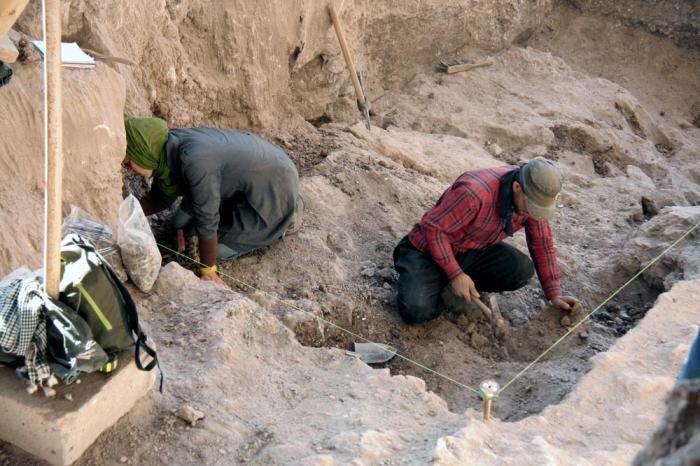Excavation sheds new light on ancient mine in Zanjan

TEHRAN – A team of Iranian archaeologists has recently finished an archaeological season on a sloping hill situated near an ancient mine that previously yielded well-reserved corpses of entrapped miners in Zanjan.
The remains of a workshop space with large quantities of ash and charcoal as well as clay and stone structures were discovered during this survey, archaeologist Abolfazl Aali said on Saturday.
“Based on the existing findings, including pottery pieces, it is likely that the uncovered works are from the Sassanid period, which will give us more information about the purpose and exact date of the site,” he added.
Authorized by the Research Institute for Cultural Heritage and Tourism, the excavation also aimed to explore any possible connections existing between the hill and the ancient mine of Chehrabad, he mentioned.
Previous rounds of excavations of the mine yielded some well-preserved salt mummies and their belongings from 1993 onwards. The findings have been put on a show at the National Museum of Iran, Zanjan’s Zolfaghari Archaeological Museum, and joint Iranian and German exhibitions under the names “Man in Search of Resources” and “Death in Salt.”
What was a catastrophe for the ancient miners has become a sensation of science. Sporting a long white beard, iron knives, and a single gold earring, the first salt mummy was discovered in 1993. He is estimated to be trapped in the mine in ca. 300 CE. In 2004, another mummy was discovered only 50 feet away, followed by another in 2005 and a “teenage” boy mummy later that year.
In 1993, miners in the Douzlakh Salt Mine, near Hamzehli and Chehrabad villages, accidentally came across a mummified head. The head was very well preserved, to the extent that his pierced ear was still holding the gold earring. The hair, beard, and mustaches were reddish, and his impressive leather boot still contained parts of his leg and foot, according to the Ancient History Encyclopedia.
The first mummy, dubbed the “Saltman”, is on display in the National Museum of Iran in Tehran. He still looks very impressive. The third, fourth, and fifth “saltmen” were also carbon-dated. The third body was dated and placed in 2337 BP, the fourth body in 2301 BP, and the fifth mummy was dated to 2286 BP, placing them all in the Achaemenid period.
The isotopic analysis of the human remains revealed where these miners were from. Some of them were from the Tehran-Qazvin plain, which is relatively local to the mine’s locality, while others were from north-eastern Iran and the coastal areas around the Caspian Sea, and a few were from as far away as Central Asia.
Furthermore, the archaeozoological finds, such as animal bones found within the context of the saltmen, showed that the miners might have eaten sheep, goats, and probably pigs and cattle, as well. The archaeobotanical finds recorded showed different cultivated plants were eaten, indicating an agricultural establishment in the vicinity of the mine.
The wealth of fabric and other organic material (leather) worn by the saltmen have allowed a thorough analysis to be undertaken, detailing the resources used to make the fabrics, the processing, the dyes used to color the fibers of the garments, and not least they offer an excellent overview of the changes in cloth types, patterns of weaving, and the changes of the fibers through time.
Saltman No. 5 had tapeworm eggs from the Taenia sp. genus in his system. These were identified during the study of his remains. The find indicates the consumption of raw or undercooked meat, and this is the first case of this parasite in ancient Iran and the earliest evidence of ancient intestinal parasites in the area. The best preserved and probably the most harrowing of the saltmen is Saltman No. 4. A sixteen-year-old miner, caught in the moment of death, crushed by a cave-in.
The oldest-known mine on the archaeological record is believed to be the Ngwenya Mine in Eswatini (Swaziland), which radiocarbon dating shows to be about 43,000 years old. At this site, Paleolithic humans mined hematite to make the red pigment ochre. Moreover, mines of a similar age in Hungary are believed to be sites where Neanderthals may have mined flint for weapons and tools.
ABU/MG
Leave a Comment